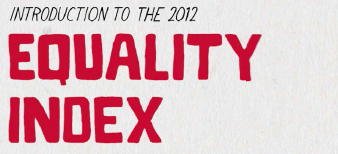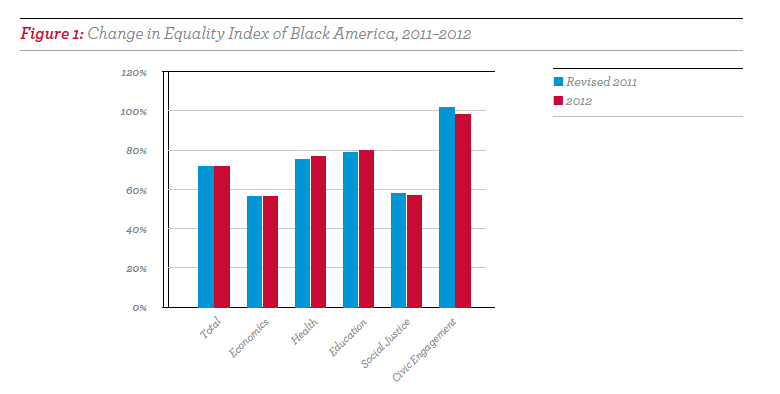2012
The 2012 Equality Index of Black America stands at 71.5% compared to a revised 2011 index of 71.4%. Revisions to the previous year’s index are done for greater comparability across years and reflect data points that have been corrected, changed, removed from the current year’s index or reweighted so that less emphasis is placed on older data. In a ranking of the five broad categories included in the Equality Index, the most inequality between black and white Americans is in the area of economics (56.3%) followed by social justice (56.8%), health (76.5%), education (79.7%) and civic engagement (98.3%). Relative to last year’s Equality Index, there was little change in 2012 because improvements in health (from 75% to 76.5%) and education (from 79% to 79.7%) were o±set by a loss of ground in the other three areas—civic engagement (from 101.8% to 98.3%), social justice (from 58% to 56.8%) and economics (from 56.6% to 56.3%). A comparison of the revised 2011 and 2012 Equality Index is shown in Figure 1.
 Civic engagement is typically the one area where Black America exceeds equality with White America. But in 2012, this index fell below 100% for only the second time in eight years. The decline in this year’s civic engagement index was the result of a common trend in reduced voter registration and participation in nonpresidential election years, but given the record numbers of registered voters and voter turnout for 2008, the contrast with 2010 was even more pronounced. As a result, the black-white voter registration index fell from 95% in 2011 to 92% in 2012 and the black-white voter participation index fell from 98% in 2011 to 90% in 2012.
Civic engagement is typically the one area where Black America exceeds equality with White America. But in 2012, this index fell below 100% for only the second time in eight years. The decline in this year’s civic engagement index was the result of a common trend in reduced voter registration and participation in nonpresidential election years, but given the record numbers of registered voters and voter turnout for 2008, the contrast with 2010 was even more pronounced. As a result, the black-white voter registration index fell from 95% in 2011 to 92% in 2012 and the black-white voter participation index fell from 98% in 2011 to 90% in 2012.
The second largest decline was in the area of social justice. The decline here was driven primarily by increased occurrences of African Americans being stopped while driving as occurrences among whites decreased. The black-white stopped while driving index fell from 110% in 2011 to 95% in 2012.
The lost ground in civic engagement and social justice was partially o±set by gains in health. Specifically, for African Americans, there were 23.4 fewer deaths per 100,000 people, but an additional 2.9 deaths for whites. This raised the blackwhite death rate index from 78% in 2011 to 80% in 2012. There was also some reduction in illicit drug and tobacco use by African Americans relative to whites, improving each of these indices by 10 percentage points and 5 percentage points, respectively. Finally, there was some progress in the number of children’s AIDS cases for African Americans that raised the index for this variable from 7% in 2011 to 22% in 2012. Yet, despite this small step forward, AfricanAmerican children remain far more vulnerable to contracting AIDS than white children.


 Equality Index
Equality Index  Senate Report
Senate Report  2020 SOBA Essays
2020 SOBA Essays  2019 Report
2019 Report 